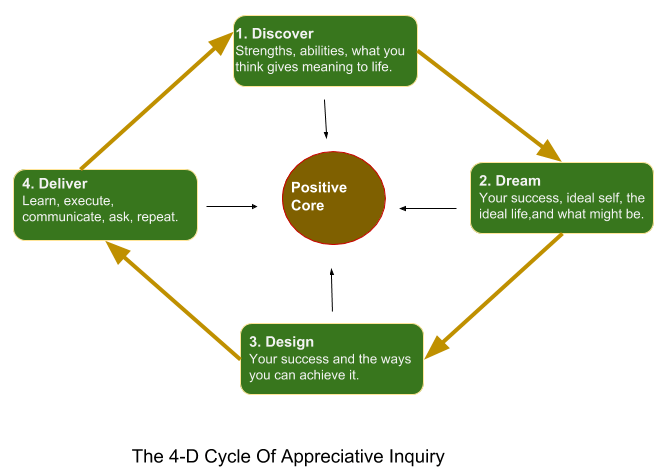4 Appreciative Inquiry Tools, Exercises and Activities
 Appreciative inquiry is about seeking the best in people – in the way they work, they live, and they behave.
Appreciative inquiry is about seeking the best in people – in the way they work, they live, and they behave.
Initially, appreciative inquiry (AI) was a “fundamental shift in the overall perspective of organizational development that took into account the entire human functioning – including strengths, possibilities, and success.”
The contemporary concept of AI came into focus after the article by David Cooperrider and Suresh Srivastava in 1987, where they coined that problem-solving is ‘overused’ in organizational contexts and that active inquiries would perhaps be more helpful in creating innovations and ideas in the industry.
According to them, appreciative inquiry helps in:
- Building the core strengths of an organization.
- Shifting the focus from organizational weaknesses to organizational strengths.
- Letting individuals as well as the industry stick to its fundamental principles.
- Bringing a wholesome change that benefits every aspect of the firm.
AI aims to explain how human growth and organizational success flow in the direction of constructive change because of positive and persistent inquiry, and it works around five core principles:
- The Constructionist Principle
Which states that our beliefs shape our actions. We do what we feel is right, and this forms the organizational culture as a whole. - The Simultaneity Principle
States that appreciative inquiry or the way we question our internal and external systems help in bringing about the desired change. - The Poetic Principle
States that performance culture in an organization grows based on expressions and communication within the human personnel. How we talk to each other, the stories that we share at work, and the emotions that attach employees is what counts for success or failure. - The Anticipatory Principle
Proposes appreciative inquiry happens when we raise questions on things that have meaning to us now, or that will have some value for us in the future. - The Positive Principle
Appreciative inquiry evokes positive emotions like hope, inquisitiveness, and motivation, all of which collectively contribute to changing the work environment for the better.
Before you continue, we thought you might like to download our three Strengths Exercises for free. These detailed, science-based exercises will help your clients realize their unique potential and create a life that feels energizing and authentic.
This Article Contains:
- What are Appreciative Inquiry Tools and Exercises?
- Benefits of Using Appreciative Inquiry Tools
- 4 Tips and Techniques For Application
- 4 Appreciative Inquiry Tools
- 10 Exercises and Activities for Applying AI
- AI Team Building Activities
- 5 Appreciative Inquiry Games
- Appreciative Inquiry Icebreakers
- Types of AI Icebreakers
- 5 AI Worksheets (Incl. PDF)
- Appreciative Inquiry Survey
- Other Resources
- A Take-Home Message
- References
This article is an in-depth exploration of how we can use appreciative inquiry tools and exercises for individual and organizational growth.
Let us start the discussion with a short introductory video on AI:
What are Appreciative Inquiry Tools and Exercises?
Appreciative inquiry typically undergoes four stages, which is more popularly known as the 4-D cycle of AI (BJ Seminars International, n.d.).
- Discovery – Acknowledging and appreciating what ‘is.’
- Dream – Imagining and appreciating what ‘will be.’
- Design – Deciding what ‘should be,’ and how we can move from reality to the ideal position that we have imagined.
- Delivery – Creating or building ways to achieve the ‘dream’ and applying the strategies to practice.
Appreciative inquiry tools and exercises come into the picture at the third and fourth stages of the 4-D cycle. Broadly, AI tools are a set of rules or practical hacks that we can use individually or as a team to aim for a positive change at an organizational level.
AI tools are strategic plans and practices that create an impetus toward large-scale corporate ventures. They give shape to the company’s ethical standards, codes of conduct and improve client satisfaction from all aspects.
Appreciative inquiry tools also help in:
- Bringing together individuals who share similar traits and behavioral patterns within an organization.
- Providing quantitative analysis and feedback that fosters organizational growth.
- Capacitating and inspiring people to initiate the development process.
- Facilitating each other with skills, knowledge transfer, and training to maximize productivity as a whole.
Benefits of Using Appreciative Inquiry Tools

Some of their benefits include:
- Open communication
- More engagement and work responsibility
- Scope for developing new skills
- Scope for improving existing skills
- Better decision-making power
- Attaining a positive learning environment
- Fostering a conducive environment at work.
4 Tips and Techniques For Application
As mentioned before, appreciative inquiry is the skill of asking relevant and positive questions (see Appreciative Inquiry Questions) that strengthen individual and organizational strength.
AI is collaborative and impacts several areas of functioning, including:
- Education
- Healthcare and mental health
- Small business, micro-business, and start-ups
- Overall job satisfaction and work motivation
- Interpersonal relationships of individuals both at personal and professional levels
- Collaborations and global transactions in companies.
AI tools and applications are realistic and straightforward. They are flexible and easy to use, and here are some practical tips on how we can make the most of them:
1. Select positivity as the prime focus
An efficient appreciative inquiry model focuses more on what has worked best for the company rather than what did not work out. For example, individuals or teams who rely on a positive AI approach would replace negative questions with more positive orientated ones. For example: “why were clients unhappy and complained about us?” could be replaced with affirmative inquiries such as “what made our clients happy earlier? Can we improvise on the same line?”
A positive shift in the questions we ask ourselves and the company as a whole is the first and a significant step to bringing about the desirable changes in the workforce. The main idea here is to attend more to what ‘we want’ and less on what ‘we don’t want.’
2. Explore the exceptionality of the methods
Positive questions rewire our brain to filter only the fruitful pieces of information and focus on our internal strengths. An excellent way to ensure this happens is to investigate and ask ourselves what went particularly well after applying appreciative inquiries.
Exploring the advantages of the questions helps in discovering their unique capabilities. It also helps with understanding which areas of functioning they facilitate the most. For example, we should understand whether it is the tone, or the language, or the content of the AI that brought about the positive consequences and identify those areas as the exceptionality of it.
3. Share to gain perspective
Appreciative inquiries extend to involve numerous individuals, and work wonders in creating a positive organizational change. When we share our life incidents, inspirational stories, and exchange perceptions with each other, the likelihood of creating a productive AI structure increases manifold.
Besides, it also allows for the smooth transmission of positive energy from one person to another and positively impacts our professional development (Capra, 2002).
4. Keep room for innovation and improvisation
Whether the AI was successful or not, it is always good to continue improvising them. We can do so by regularly monitoring the outcomes, communicating with leaders about new ways of implementing the strategies, or by developing Appreciative Inquiry workshops to spread awareness about the inquiry systems.
Whatever way we choose, the whole idea is to keep moving forward and explore the endless benefits of using appreciative inquiry.
4 Appreciative Inquiry Tools

1. Appreciative Inquiry in Evaluation Practice By Hallie Preskill
Hallie Preskill is a Doctorate and a Professor of Behavioral Sciences at the Claremont Graduate University. She is a renowned author and has done great works in the field of appreciative inquiry and organizational learning. Her workshops and research publications are used by professional and educational organizations to alleviate the inhibitions related to asking the right questions, at the right place, and to the right person.
Her workshop on Appreciative Inquiry is a collection of principles and AI research-backed techniques to conduct positive AI sessions with more efficacy.
Her manual is suitable for individuals of all ages and includes tasks such as:
- One on one interview sessions with co-participants.
- Taking turns to narrate each other’s stories.
- Asking appreciative interview questions such as ‘three things you value the most,’ ‘best experience with clients so far’.
- Building listening skills by actively paying attention to each other’s stories and taking notes while doing the same.
- Collaborating in the workshop to build a joint vision of the future and discuss ways to get there.
The workshop by Preskill guarantees a positive shift in the mindset of the participants from a deficit viewpoint to a strength-based approach.
2. Appreciative Inquiry Coaching Toolkit
This toolkit is based on the 4 D’s of appreciative inquiry – discovery, dream, design, and deliver.
It follows a step-by-step approach and discusses practical strategies of AI that work best in each of the four stages of the 4-D cycle.
For example, the relevant AIs in the discovery and dream phase would be asking ‘what’ to the existing systems and getting the right answers where participants wish to see themselves in the future.
In the design and delivery phases, the AIs would focus more on the ‘how’ aspect of it, exploring better ways to implement the thoughts and gathering knowledge on how to put ideas into actions.
3. KS toolkit
The KS toolkit for AI is an adaptation of the Appreciative Inquiry Commons Model. It is a brief model containing the most relevant information that we can successfully apply in personal and professional fronts. The KS toolkit overviews the basics of how and when to use AI.
It is a great resource to ensure that the participants have a clear insight before they take the plunge. Besides, the toolkit has additional sources like examples, stories, and useful hacks that participants can follow to optimize the benefits of AI.
4. The Do It Now Appreciative Inquiry Toolkit
The Do It Now Appreciation Toolkit is a collection of appreciative inquiry exercises used in an AI workshop in Nepal, 2000. The tasks are varied and explained in details in the downloadable resource in the toolkit. The Do It Now Toolkit is a highly recommended set of exercises that individuals at any stage can use to build their skills thoroughly.
It is research-backed, successfully tested, and provides an excellent base for companies who are planning to implement AI as a part of their organizational system.
You can learn more about the research and download the exercises from the link above.
10 Exercises and Activities for Applying AI
Appreciative inquiries are flexible and applied in a variety of ways (see our article on How To Apply Appreciative Inquiry). The AI tools and exercises mostly vary depending on the target population and the contexts in which they come into play.
Here are ten AI activities that are more or less versatile and work equally well for all people and settings. Some of these exercises were also a part of the Do It Now toolkit mentioned earlier and proved to be extremely useful in the workshop it was first used in.
1. Appreciative meditation exercise
Appreciative meditation is a short yet powerful exercise to build a firm intention for appreciative inquiry. Usually used as the first exercise in most AI programs, the task merely involves collecting ourselves for a moment.
We can do this by breath control, thought monitoring, or attending to an external focal point and immersing ourselves entirely into it for a while. Appreciative meditation as the initial task makes the participants aware of their internal feelings and helps them realize why they want to invest in AI.
2. Individual self-discovery
This is a fun activity and works exceptionally well with kids and youngsters. The practice involves giving paper and pen to each participant and asking them to recall and sketch one of the happiest moments of their lives. The sketch need not be too elaborate, just a simple illustration that the respondents would then take turns to describe.
In the discussion part of this exercise, each child comes up with a brief narrative of the story they have sketched, and others are encouraged to listen to the story and inquire more about the details.
The task benefits the respondents and the audience in three main ways:
- They relive a happy moment of the past and experience the positive emotions related to it.
- They can reflect on their inner feelings and emotions while they narrate the stories.
- By listening to others asking, individuals gain insight into what an AI session looks like and how they can make the most of it with their narratives and questions.
3. Group discovery
This is an interactive AI exercise used in many organizational setups to promote employee engagement and team spirit. The activity is to form groups and discuss the achievements of each member of the team.
The administrator presents each group with a bunch of pens and a single sheet of paper and urges each team to represent their achievements pictorially.
4. Appreciative storytelling
Storytelling encourages participants to come up with their life stories that have some meaning to them and can inspire others. The aim is to make participants realize their experiences can be of value to someone else.
By sharing their stories and listening to others, participants build a sense of cohesiveness among themselves and motivate each other to keep going. As a result, they do not hesitate to express their concerns, ask for advice, and give their suggestions wherever appropriate to do so.
5. Appreciative acknowledgement
A positivity booster, this short exercise fills the respondents with energy and appreciation about each other. One or more persons are randomly chosen to come up and share one good thing that they like about each person present in the room.
Appreciative acknowledgment can be one long session allowing all participants to get their chance or it can be a daily component in an AI workshop where respondents take turns to appreciate each other every day for a few minutes in between sessions.
The aim is to build a mutually benefiting relationship among participants so that they can see and bring out the best in each other.
6. Morning news exercise
The morning news exercise was used with participants of the Kathmandu workshop. It is a group activity where participants are assigned to groups and work as a ‘Press Team.’
Their tasks involve collecting useful bits of information from the daily newspaper and reading it out at the workshop session every morning. Members take turns to present each piece of news so that each person gets a chance to be the presenter as well as an active listener.
7. Dream exercise
As the name indicates, this is an imagery-based exercise where the participants close their eyes for a couple of moments and imagine themselves returning home after an extended stay outside.
The administrator guides the respondents to think about everything they would have wanted to achieve by then and try to feel the emotion of returning home after so long. After the session is over, participants take turns to come up and share in detail what they imagined, how they saw themselves, and what changes they desired to see in their lives after so long.
8. Appreciative communication exercises
Susan Gaddis, a certified life coach and wellness guide, coined a manual for positive communications systems and appreciative inquiry. Her works focus on building awareness on the benefits of clear communication and appreciative introspection.
In the ‘Good Communications’ manual, she has put forth some simple, scientific, and objective AI measures that are easy to understand and provide a quick analysis of how appreciative we are towards ourselves and others.
Learn more about her exercises here.
9. The problem to opportunity exercise
Mac Odell proposed this exercise for fostering appreciative inquiry through challenging the existing problem areas and replacing them with potential opportunities.
The first part of the task is about ruling out what is currently lacking and then replacing the deficits with the scope of new possibilities.
For example, if the problem is a weak social connection within the organization, then the participants would first chalk out what has led to the challenge and what they may think can solve it. After that, they would draw a separate map or chart with the solution part – string interpersonal connections in this case, and formulate the causal factors and ways to attain the goal.
You can learn more about the administration and application of this exercise here.
10. AI advertising exercise
An adaptation of the Open Space Technology used by the APA framework, this exercise invites participants to form an advertisement with words, pictures, or graphics on any aspect of the dream they aspire to fulfill. After completing the sketch, the members come up one by one and present their advertisements as though they are ‘selling’ them.
The response and feedback they get from the audience during the presentation, as well as the intuitions that work while they are delivering their advertisements, serve to provide an understanding of how they should plan on achieving it in real life.
The facilitators develop interactive sessions for discussing the design and execution part of the mock-ups, and participants encourage and appreciate each other’s efforts throughout the practice.
AI Team Building Activities

Many successful firms of different fields rely on professional group activities that are incredibly solution-focused and guarantee success in the majority of the times.
If you are looking for some great ideas for incorporating AI in your organization, these tips can get you started:
1. AI team activities involve a large number of individuals
The more individuals in a team-building AI, the better the results. Whether we are the facilitators or the participants of the AI program, we must ensure that more people join the activities and each of them feels important as a part of the group.
When more people work together, there are more significant exchanges of positive energy and more inputs come up in the form of personal stories and experiences.
2. A sense of trust is vital for success
AI group activities can create a sense of trust in the team by introducing trust scales in the program and asking participants to score their level of confidence in themselves and others.
Marking the trust level allows open communication among members about what influence their trust in themselves and why they do or do not trust someone.
3. Set up talk-circles
Talk circles are open spaces where people are free to talk with others and share their views on customer service, organizational leadership, and team building at work.
Talk circles work best when they are amalgamated within the AI team activities and practiced daily.
4. Encourage groups to dream together
Groups that imagine together work better as a team. To promote this, we can set up brief sessions during each activity, say for five minutes, where members would visualize a dream and share their feelings.
This could be a group goal, any personal achievement, or imagery of what the ideal workplace would look like. Communicating every tidbit of the visualization helps the members connect and agree on a single goal (dream) that they could then seek to achieve.
5. Promote the exchange of knowledge and information
Exchange of information can happen in different ways, such as 1-minute wisdom bites where each member gets one minute prior or post the activity to share the most relevant information they got that day.
Knowledge transfer creates a cultural shift in the organization as a whole and drives the employees to engage in a valuable exchange of positive news that can create a better ambiance at work.
Appreciative team-building activities create a conducive work environment where employees can feel good about themselves and others. Efficient and compassionate leaders today believe that a healthy and highly functioning team is a primary requisite for success.
Team building AI exercises ensure a sustainable and positive performance culture that invites long-term gains and ensures satisfaction at all levels of functioning.
5 Appreciative Inquiry Games
Although one would typically expect Appreciate Inquiry to only apply to the work environment, it can also be practiced at school. The following section includes games as well as research findings.
1. Thumb wrestling game
Many of us have thumb wrestled in our school days and must have so many fond memories attached to this game! But did you know that thumb wrestling is also a great AI tool for team building and performance enhancement?
The game is simple:
- Ask the participants to choose a partner to thumb wrestle with and let them lock their finger once they are ready to start the game.
- Explain the rules clearly to all the participants so that they do not end up hurting each other.
- Start the game by asking the participants to wrestle with each other for one minute and give shoutouts for each time they score.
- Make multiple pairs who compete in the game and let them collaborate as a team for scoring higher.
The best part of thumb wrestling as an AI tool is that is can be used for all populations and is a great way to promote team spirit within individuals.
2. Appreciative learning games in schools
Appreciative inquiry, when started earlier, yields the best results. For example, students and youngsters who learn to use AI exercises and activities in their educational institutions can internalize the practice better than others. They are likely to show similar positive traits in all other walks of life more spontaneously than others.
Studies have shown that children who went to schools that promoted AI through daily activities and games were more competitive and self-driven than others. They were more creative, positive-minded and regardful of others they work or study with (Eow, Wan Zah, Rosnaini, & Roselan, 2011).
3. Appreciation cards, kudo cards
Praise words never fail! Appreciation or Kudo cards is a popular AI game that enhances employee satisfaction and happiness.
Expressing ‘Kudos,’ meaning appreciation or acknowledgment is the key factor in this game. Appreciation cards can be small thank-you notes or simple words of recognition from the team leader or supervisor.
Managers and leaders often use this game as a means of acknowledging the employees’ hard work and appreciating their efforts. Positive feedback from superiors and co-workers brings an instant feeling of happiness and provides a positive thrust to keep working hard.
4. Agile games
Agile games are used as appreciative inquiry instruments to solve authentic business issues and manage conflicts. They are a collection of activities and exercises that focus on manifesting positive workplace actions such as group cohesiveness, multitasking abilities, time management, etc.
The tools used for these games involve teaching, role modeling, and interactive games and the collaborative nature of the exercises helps the participants in understanding, discovering, and executing their dreams.
5. Action learning games
Action learning games are mostly group activities that facilitators regularly conduct with other appreciative inquiry techniques. In action learning games, there is a presenter who narrates an incident, a problem, or a life experience.
The others in the group are active listeners who fully attend to the story, take notes while listening, and comes up with relevant questions after the narration is over. The facilitator motivates each person to come up with at least one question and explain how the answer would help them in their lives.
The discussions participants have with each other during the session unlock the thought blocks and make way for positive self-reflection.
Appreciative Inquiry Icebreakers

They are simple, catchy, and relevant tasks that the facilitators introduce in the group session to promote appreciative inquiry in the group (Silberman, 2011).
Hogan (2005) pointed out that icebreakers play a predominant role in an appreciative inquiry by:
- Making participants accustomed and well-adjusted to each other.
- Creating space for open communication and equal responsibility among all members of the organization.
- Promoting positive interpersonal relationships in the workplace.
Icebreakers are mostly practiced in groups, where many individuals work together. Tuckman (1965) said that there are four stages of group development, namely:
- The Forming Stage – where members come together and create the team.
- The Storming Stage – when they discuss and explore the group goals and the means to achieve them.
- The Norming Stage – where the rules and group standards come into the picture.
- The Performing Stage – where the group members embark on executing the plans and achieving the targets.
According to Tuckman, icebreakers work best when they are used in the early stages of group development (i.e., the forming and the storming stages).
Introducing them earlier ensures less performance anxiety in the participants and more excitement at being a part of the performing team. And once the members become familiar with the icebreakers, they can use them repeatedly to instill energy at different levels of the AI sessions (Chlup & Collins, 2010).
Types of AI Icebreakers
There are three broad categories of icebreakers in appreciative inquiry.
1. The Just for Fun Icebreakers
These make participants comfortable and provide an initial energy boost to know and communicate with each other.
2. The Introductory Icebreakers
Introductory Icebreakers make the participants familiar to new topics, new group agendas, and also new members of the group. They may be funny and informal, but usually aim at achieving a group goal.
3. The Topic-based Icebreakers
They are more specific, detailed, and focus on the ultimate goal of the session.
There is a vast range of icebreakers to choose from. While some of them are more suited to organizational contexts, other icebreakers may be more relevant for educational institutions, or counseling and rehabilitation purposes.
Here are three appreciative icebreakers that are more generalized and can be incorporated in AI across different spheres:
i. Friends Indeed Icebreaker
Friends indeed is an introductory icebreaker that helps people get to know each other in a group. It uses physical name cards that make the task more fun and enjoyable, and suitable for using with kids as well.
The job is to write their names on the name cards and stand in a circle with the facilitator in the middle. The facilitator would then call out statements, and those for whom the statements hold true will go and stand with each other, maintaining the circle.
In each round, the odd person or persons would come to the center of the ring and call out the next statements aloud. The comments are usually simple and easy, for example – ‘friends who have pets at home’, ‘friends who are late-risers’, ‘friends who love chocolates’, etc.
The game is an excellent way for participants to know each other, participate in a group task, and realize that they have something in common, which makes the bonding easier.
ii. Storytelling AI Icebreaker
Storytelling techniques are very common AI icebreakers. They are flexible, don’t require any special arrangements for administration, and help people voice their thoughts and emotions.
The task involves allowing some time (usually 2-3 minutes) to each group member to share one story with the group. The stories can be personal experiences, or the facilitator can provide cues such as ‘a story about the best manager you have worked with so far’, ‘ a story about your biggest professional achievement and why you think you could attain it.’
The only rule of this icebreaker is that the story participants choose must have some value and a positive note in it. Storytelling sessions usually take longer as there are many individuals involved, and each person gets a fair chance to tell their story.
Once all the stories have been shared, the person in charge of the session recapitulates the critical elements of each story and discusses how the group can use them for learning purposes.
iii. Strength-based Icebreakers
Strength-based icebreakers combine creativity and positive imagery into the team for getting the desired outcomes. Strength-based icebreakers are a recent phenomenon that came up as a part of an experiment to explore how appreciative learning and appreciative inquiry can help training and orientation programs.
Researchers promoting these more intellectual and individualized strategies argue that if icebreakers can build individual strengths and potencies, they can be more useful than the traditional AI icebreakers.
Undoubtedly, the strength-based approach gave a new dimension to the application of AI icebreakers, but whether it can take over the conventional interventions is still a matter of investigation.
If this is something worth considering for your next AI session, take a look at this strengths-based therapy article for ideas.
4 AI Worksheets (Incl. PDF)

1. Appreciative Inquiry Worksheet For Personal And Organizational Use
A short and straightforward worksheet for charting the four D’s of appreciative inquiry. This worksheet is the perfect option for self-exploration and introspection of where we are and how we can reach the final destination. It encourages reflection on being more regardful and considerate of ourselves and others.
The task is self-directed, comes in a two-page form, and works equally well as a personal or group AI intervention.
2. Appreciative Inquiry Worksheet by Change Activation
If you are looking to start an AI program in your workplace and expect many individuals as potential participants to the program, then this could be a one-stop go to for you.
Change Activation is an online resource that has it sorted for people and organizations using and promoting appreciative inquiry, and their worksheets and manuals are great to have in the collection for a successful AI program.
3. Appreciative Inquiry Workbook for Children
This set of worksheets and exercises was used in a school program in Houston, Texas, and has valuable content for building AI in school children.
The workbook includes simple illustrations of the 4D cycle of appreciative inquiry, followed by tasks for self-reflection, positivity, and self-expression. It is undoubtedly a powerful resource to help kids understand and explore success through an appreciative inquiry from the very beginning of their lives.
4. Appreciative Inquiry Quiz
The AI quiz is a short exercise focused on building knowledge application, information exchange, and reading comprehension. The test consists of multiple-choice questions on the basis of appreciative inquiry and is easily scoreable.
The quiz is suitable as a follow-up measure for participants of an AI program to ensure they have internalized the concept and are ready to use them in their personal and professional lives.
Appreciative Inquiry Survey
Dr. David Cooperrider, the founder of the AI methodology, mentioned the Appreciative Inquiry Survey in his research publications and appreciative inquiry books. The survey gained immense popularity and was later used in different professional setups to introduce the concept of AI in employees.
Dr. Cooperrider noted about this first at the annual meeting of the ONL (Organization of Nurse Leaders of Massachusetts), in 2014, and previously used it as a part of the AI certifications he provided to professionals.
The survey is now used in healthcare, educational, and organizational sectors and offers comprehensive knowledge and suggestions of how appreciative the respondents are, and how they can be trained to enhance their AI skills.
Other Resources
There are no limits to the ways we can embrace and apply AI in our lives. Whether we practice them individually or enjoy its benefits from the group activities, the result of using AI is nothing but heightened motivation and achievement.
We have already seen a few exercises and games in the previous sections, and here are some more riches on appreciative inquiry to get the ball rolling.
Appreciative Inquiry: A Conversation with David Cooperrider
Playful inquiry by Robyn Stratton-Berkessel
How to Do An Appreciative Inquiry Interview by Lindsey Godwin
Appreciative Inquiry In Organizational Life by David L. Cooperrider and Suresh Srivastva – a PDF.
Appreciative Inquiry and the Power of Positive Question by Ludema, Cooperrider, and Barrett – a PDF.
A Take-Home Message
John Lubbock said, “What we see depends mainly on what we look for.”
Appreciative Inquiry is about discovering the root causes of success rather than exploring the causes of failure. It builds the power to create our world with the questions we ask and the way we apply the solutions in our lives.
In a nutshell, AI is calling for a positive shift of energy from repairing the old to creating something new. It allows us to discover our strengths, acknowledge the efforts of others, and build the spirit for squeezing innovation with dreams. And as we know, “Positive actions, combined with positive thinking, results in success” (Shiv Khera).
We hope you enjoyed reading this article. Don’t forget to download our three Strengths Exercises for free.
- BJ Seminars International. (n.d.). The 4-D cycle. Retrieved from https://bjseminars.com.au/our-approach/appreciative-inquiry/the-4-d-cycle/
- Capra, F. (2002). The hidden connections: Integrating the biological, cognitive, and social dimensions of life into a science of sustainability. Doubleday.
- Chlup, D. T., & Collins, T. E. (2010). Breaking the ice: using ice-breakers and re-energizers with adult learners. Adult Learning, 21(3-4), 34-39.
- Cooperrider, D., & Srivastva, S. (1987). Appreciative inquiry in organizational life. In R. Woodman & W. Pasmore (Eds.), Research in Organizational Change and Development (Vol. 1, pp. 129-169). Jai Press.
- Eow, Y. L., Wan Zah, W. A., Rosnaini, M., & Roselan, B. (2011). Appreciative learning approach as a pedagogical strategy and computer game development as a technological tool in enhancing students’ creativity. Journal of the Research Center for Educational Technology, 7(2), 58-85.
- Hogan, C. (2005). Understanding facilitation: Theory and principle. Kogan Page Publishers.
- Silberman, M. L. (2011). 101 Ways to make training active (Vol. 1). John Wiley & Sons.
- Tuckman, B. W. (1965). Developmental sequence in small groups. Psychological Bulletin, 63(6), 384-399.
Let us know your thoughts
Read other articles by their category
- Body & Brain (49)
- Coaching & Application (57)
- Compassion (26)
- Counseling (51)
- Emotional Intelligence (24)
- Gratitude (18)
- Grief & Bereavement (21)
- Happiness & SWB (40)
- Meaning & Values (26)
- Meditation (20)
- Mindfulness (45)
- Motivation & Goals (45)
- Optimism & Mindset (34)
- Positive CBT (28)
- Positive Communication (20)
- Positive Education (47)
- Positive Emotions (32)
- Positive Leadership (18)
- Positive Parenting (4)
- Positive Psychology (33)
- Positive Workplace (37)
- Productivity (16)
- Relationships (46)
- Resilience & Coping (36)
- Self Awareness (21)
- Self Esteem (38)
- Strengths & Virtues (31)
- Stress & Burnout Prevention (34)
- Theory & Books (46)
- Therapy Exercises (37)
- Types of Therapy (64)





What our readers think
Is it possible to get the link for the Appreciative Inquiry Workbook for Children with worksheets? Currently, the link is not working. Thank you!
-Marion
Hi Marion,
Thanks for bringing this to our attention and our apologies! The link has been fixed now and you can access this resource here.
– Nicole | Community Manager
Thank you for this clear and resourceful article. I found it very useful and enjoyed watching the videos.
Madhuleena, thank you for compiling this very comprehensive set of resources about Appreciative Inquiry that includes applications and innovations in an ever-widening circle of contexts. I will be sharing it widely on social media and with my students and clients.
Hai Madhu, I am ANANDKUMAR, an Associate Professor teaching agricultural extension in India. I am living in Karaikal, a district in Pondicherry, where Shri Arbindho Ashram is located. I am working in Pandit Jawaharlal Nehru College of Agriculture & Research Institute.
I like your AI paper above.
I intend to frame a questionnaire based on the tips you suggested to know about what my students who completed a course on entrepreneurship development, think and feel about becoming an entrepreneur in future. How do you feel about it. Can you also join me? Do you have any opportunity to visit our students for this research and do something together for wellness of students?